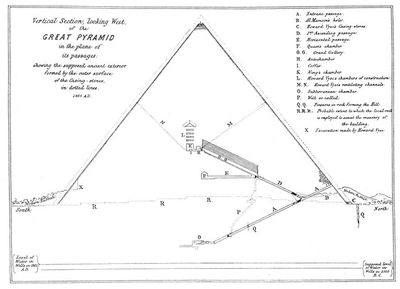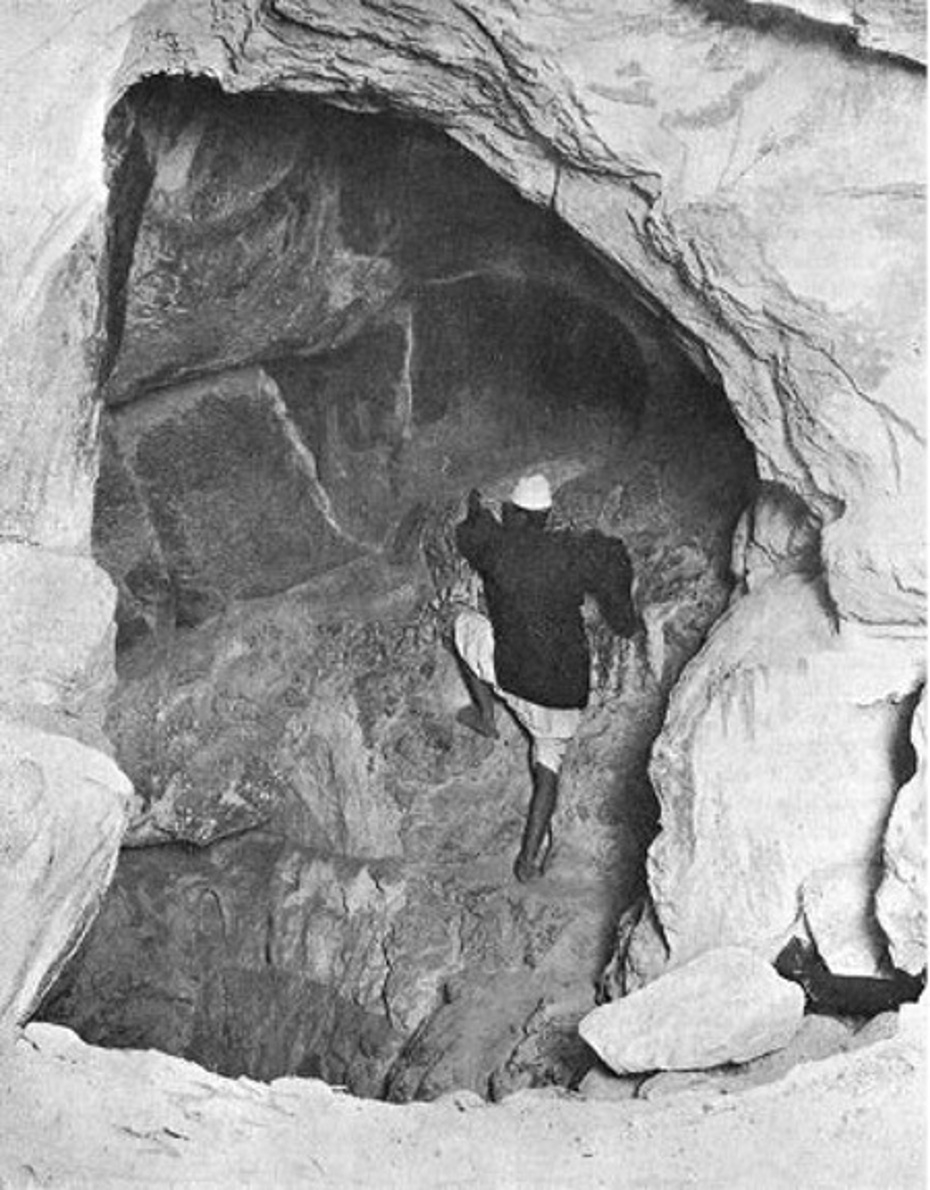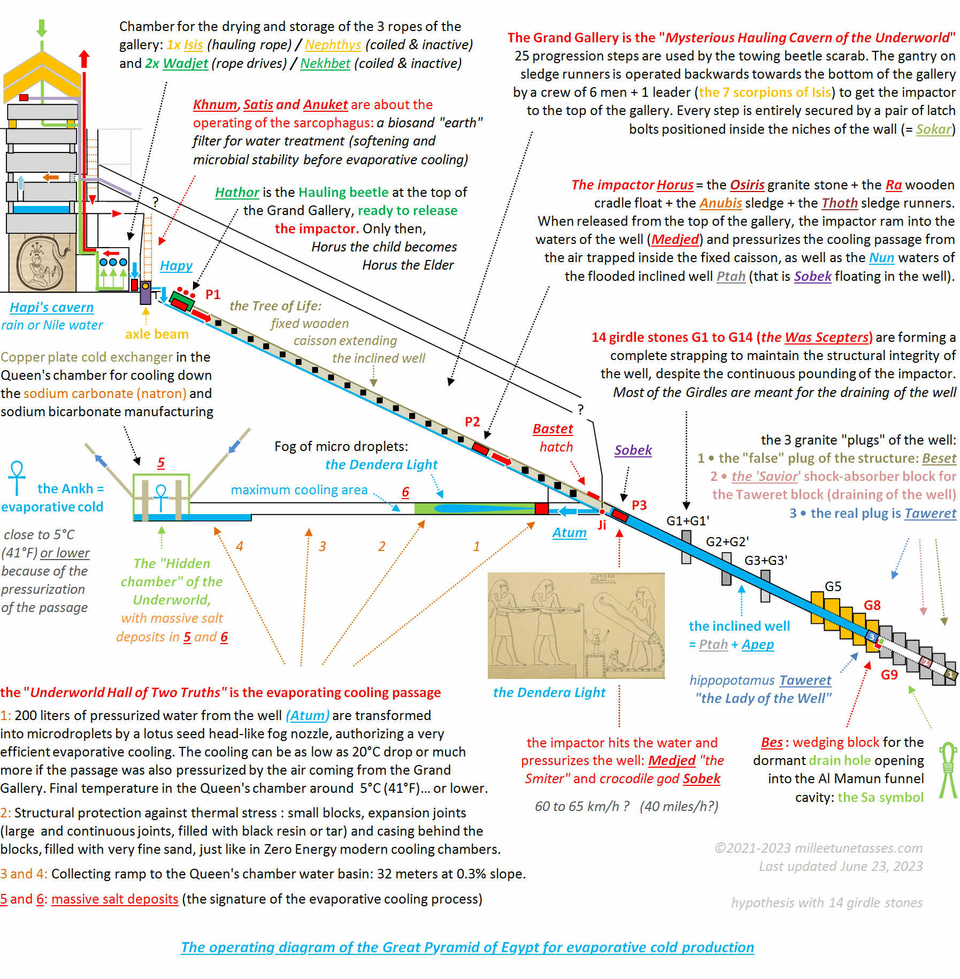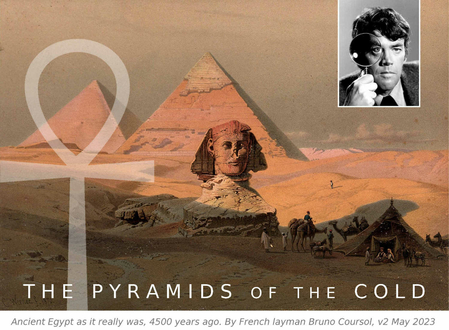- Retour accueil
- Vous êtes ici : Blog The Pyramids of the Cold v2 The Pyramids of the Cold Section 35 • The hidden secrets of the Hermetica Emerald Tablet
The Pyramids of the Cold Section 35 • The hidden secrets of the Hermetica Emerald Tablet
Publié par Bruno Coursol dans The Pyramids of the Cold v2 le 13/05/2023 à 18:46

"An imaginative 17th-century depiction of the Emerald Tablet from the work of Heinrich Khunrath (1560-1605)" : https://en.wikipedia.org/wiki/Emerald_Tablet
The Pyramids of the Cold v2 (May 2023) • Part G: the impact of the Great Pyramid on the ancient World
Section 35 • The hidden secrets of the Hermetica Emerald tablet (around 1600 C.E.)

Summary: as incredible as it sounds, it looks like the knowledge of the operation of the Great Pyramid, and in particular the operation of its inclined well, was somehow still present in the early 1600's in Germany in the form of the Emerald Tablet, a text from the Hermetica. The thing is that the Hermetica texts are attributed to the legendary Hellenistic figure of Hermes Trismegistus, a syncretic combination of the Greek god Hermes and the Egyptian god of Science Thoth.
If the tablet is mostly describing the structure of the inclined well, and in particular the position of the three granite blocks that we call today "the granite plug" of the ascending passage, it is also perfectly depicting the draining of the waters of the well, from the way it had been triggered, to the evacuation drain hole in the form of a funnel that is inside the cavity of El-Ma'mun.
There is actually almost no metaphor at all on the drawing part of the Emerald Tablet: everything is pretty much straight forward, but you simply have to understand that even if it looks like just a very "cute" scenery, with a water chute and some big rocks, it actually is all about the Great Pyramid. If you know the context of the scenery, you understand it all.
35.01 The dual technical and religious approach and encoding process
Maybe the most basic characteristic of this study, and which only appeared progressively, little by little, month after month since January 2021, is the fact that the deciphering of the ancient Egyptian civilization only occurs if you engage yourself in a dual composite representation:
• a technical approach of what really happened in the first pyramids and mastabas of the first Dynasties, until the Great Pyramid was built
• a religious approach in which all the technical approach has been "encoded" into myths, gods and goddesses
This double approach is also the chore of the Hermetica; texts which are originating as far as ancient Egypt, and refer in particular to the ancient Egyptian god of science, Thoth:
"The Hermetica are texts attributed to the legendary Hellenistic figure Hermes Trismegistus, a syncretic combination of the Greek god Hermes and the Egyptian god Thoth. These texts may vary widely in content and purpose, but are usually subdivided into two main categories, the "technical" and "religio-philosophical" Hermetica. [...] It may even be the case that the great bulk of the early Greek Hermetica were written by Hellenizing members of the Egyptian priestly class, whose intellectual activity was centred in the environment of Egyptian temples." https://en.wikipedia.org/wiki/Hermetica

"An imaginative 17th-century depiction of the Emerald tablet from the work of Heinrich Khunrath (1560-1605)". Engraved image of the "Emerald tablet" from Amphitheatrvm sapientiae aeternae, solivs verae, 1609, by Heinrich Khunrath (1560-1605). Typ 620.09.482, Houghton Library, Harvard: https://en.wikipedia.org/wiki/Emerald_Tablet
35.02 The Emerald tablet text really is about an endless cycle of slow ascent and hasty descent
The fact that this illustration of the Emerald tablet is describing the operation of the Great Pyramid brings another question now: is the text accompanying the tablet also about the Pyramid?
And the answer is yes: the text really is about the endless cycle of ascending "gently in the heavens" and "descending hastily" from these same heavens. I only found this "hastily descent" in a French translation of the texts; but in the illustration, there really is the representation of a bird engaged in a high speed dive, just like the falcon god Horus would do as the impactor.
"Truth! Certainty! That in which there is no doubt! That which is above is from that which is below, and that which is below is from that which is above, working the miracles of one [thing]. As all things were from One. Its father is the Sun and its mother the Moon. The Earth carried it in her belly, and the Wind nourished it in her belly, as Earth which shall become Fire. Feed the Earth from that which is subtle, with the greatest power. It ascends from the earth to the heaven and becomes ruler over that which is above and that which is below."
"The father thereof is the Sun, the mother the Moon. The wind carried it in its womb, the earth is the nurse thereof.
It is the father of all works of wonder throughout the whole world. The power thereof is perfect. If it be cast on to earth, it will separate the element of earth from that of fire, the subtle from the gross. With great sagacity it doth ascend gently from earth to heaven. Again it doth descend to earth, and uniteth in itself the force from things superior and things inferior. Thus thou wilt possess the glory of the brightness of the whole world, and all obscurity will fly far from thee. This thing is the strong fortitude of all strength, for it overcometh every subtle thing and doth penetrate every solid substance". https://en.wikipedia.org/wiki/Emerald_Tablet
"Le soleil en est le père, la lune est sa mère, le vent l’a porté dans son ventre ; la Terre est sa nourrice. Le père de tout le telesme de tout le monde est ici. Sa force ou puissance est entière, si elle est convertie en terre. Tu sépareras la terre du feu, le subtil de l’épais doucement, avec grande industrie. Il monte de la terre au ciel, et derechef il descend en terre" https://fr.wikipedia.org/wiki/Table_d%27%C3%A9meraude
In this French version of the "la table d'émeraude", "derechef" means "quickly, hastily".

The cavity of Al-Ma'mun only served the purpose of collecting the inclined well waters for the shutdown procedure of the pyramid. The draining of the well was triggered by the breaking of the wedging block (represented in the Bes deity) that was supporting what is now known as the upper granite plug of the ascending passage, and that was represented in the Taweret hippopotamus deity.
Photograph of the cavity of Al-Ma'mun : "Great Pyramid Passages, Volume 1, by John and Morton Edgar, 1910" : Plate LXIV, page 166: https://archive.org/details/GreatPyramidPassagesVol11910Edition/page/n174/mode/1up
35.03 The draining of the inclined well into the al-Ma'mun cavity
If the Hermetica texts are very "obscure", the above illustration made by Heinrich Khunrath in the 17th century is a lot more interesting, because believe it or not, as crazy as it looks like, the guy more than 400 years ago depicted the entire sequence of the operation of the inclined well, starting with the biosand filter "sarcophagus" to the draining of the well into the Al-Ma'mun cavity. How about that!
It is actually weird, because it all starts at the extreme right side of the picture, and then "chronologically", the operating cycle is described little by little, by simply going towards the center of the image where is the mountain, which by the way is getting very close to look like a pyramid.
• at the extreme right is the representation of the biosand filter, in its dedicated little "grotto" (the "electric room").
• then is the representation of the Grand Gallery with its hauling slope and the hauling horse (in 17th century Germany, horses were most probably better illustrations of hauling animals than the ancient Egyptian cows).
• then is the representation of what triggered the draining of the well with these 2 big and one small rocks inside the water flow. The upper big rock is of course Taweret, released from its original position when the wedging block broke under increased pressure (they most probably simply flooded the central wooden caisson to increase the water height, hence the pressure onto Taweret); of course the little rock in between the two big rocks, is the upper part of the broken Bes wedging block; and finally we have the second big rock, the "shock absorber" block deified into "the Savior" by ancient Egyptians: look how "proud" it looks like, waiting to do its job, standing in front of the two other ones.
And to show that the little block was initially supposed to be a fixed wedging block, it has even been set onto a little flat area within the river.
• finally, we have the draining of the well itself, in a perfect representation of the Al-Ma'mun cavity and its distinguishable shape of a funnel.

Gibson Dam Spillway. Brian Hollis rappels into Gibson Dam glory hole spillway. Photo by Joe Rohde: https://www.flickr.com/photos/usbr/11356922433/

35.04 The original position of the granite plug number 2 "shock absorber" block for Taweret's immobilization
Also, if it is true that the third big block, which is granite plug number one in the Operating Diagram of the Great Pyramid, isn't represented in the water with the three other blocks, if you look at the bank of the "river", you will see it: the three granite plugs of the inclined well are right there; because don't forget that this particular block never touched the water… ever!
Why would anyone have represented this block directly into the water of the river if it never touched the waters of the well?
But, if you look just at this part of the illustration, the bank of the river with the three kind of "rectangular shades" into it, and the slope of this bank, doesn't it looks exactly like my diagram?
And here is maybe the most amazing part of this Section: because of this illustration of the bank of the river, we know now the exact position in which was set granite plug number 2 "the Savior" shock absorber block, in the ascending passage and during the entire operation of the Great Pyramid. How about that!

Photograph of the cavity of Al-Ma'mun : "Great Pyramid Passages, Volume 1, by John and Morton Edgar, 1910" : Plate LXIV, page 166: https://archive.org/details/GreatPyramidPassagesVol11910Edition/page/n174/mode/1up
35.05 The funnel cavity inside the Al-Ma'mun cavity
The granite block fully appearing on the above picture, is Taweret: the former sealing block of the inclined well, which has been released by the Bes wedging block and stopped by the second granite block partially appearing on the photograph; that block is the shock absorber "the Savior" block.

"The lower butt-end of the granite plug which blocks the entrance of the First Ascending Passage of the Great Pyramid of Gizeh ; showing the space in the roof of the Descending Passage which was formerly occupied by an inset limestone block, which covered the Granite Plug and hid the entrance of the First Ascending Passage, and thus for three thousand years kept secret the existence of the upper passages and chambers of the Pyramid."
Great Pyramid Passages Vol 1 1910 edition, by John and Morton Edgar. Plate LXVIII page 172: https://archive.org/details/GreatPyramidPassagesVol11910Edition/page/n180/mode/1up
Plate LXIX, page 173; full image at: https://en.wikipedia.org/wiki/Great_Pyramid_of_Giza#/media/File:49_edgar.jpg
35.06 Granite plug number 1 was "half in the passage and half out of the passage", so its representation in the Emerald tablet is "half in the picture and half out of the picture" as well
One can think that this illustration of the Hermetica, called the Emerald tablet is a very naïve representation but it really is not. Everything has been perfectly thought through, just like ancient Egyptians when they've created their own glorification propaganda.
The lower "shadow" that looks like a rock encrusted inside the bank of the river is a perfect example of this: one can think it is half out of the picture by accident, but it really is not; and because again, this block is the lower granite plug of the ascending passage. Not only there is only the "shade" of this granite plug number 1 block into the bank of the river because this block never touched the waters of the well, but this block also had one part inside the "passage" and the other part outside the "passage", visible from the descending passage as we can see on the picture of the Edgar brothers.

Photograph of the cavity of Al-Ma'mun : "Great Pyramid Passages, Volume 1, by John and Morton Edgar, 1910" : Plate LXIV, page 166: https://archive.org/details/GreatPyramidPassagesVol11910Edition/page/n174/mode/1up
35.07 The funnel cavity inside the Al-Ma'mun cavity
The granite block fully appearing on the above picture, is Taweret: the former sealing block of the inclined well, which has been released by the Bes wedging block and stopped by the second granite block partially appearing on the photograph; that block is the shock absorber "the Savior" block.

35.08 The original positions of the 3 granite plugs of the ascending passage of the Great Pyramid
Last updated, April 14, 2023. Granite plug number 2 "shock absorber" block for the immobilization of the Taweret block after its release, has been slightly moved up in the passage in accordance with the Emerald tablet representation.

The small block in the middle of the river, looks like it just ran aground, without energy or speed: that block is a wedging block, within the flow of the current and it is by breaking it that the same current is redirected towards the funnel cavity.
35.09 The block set on the flat surface in the middle of the river which redirects the water towards the funnel cavity
Here, this is the role of the small wedging block Bes which is emphasized: because Bes wasn't moving at all, it had been represented on the draw on a flat surface within the river. The small block looks like it just ran aground, without energy or speed: the block is a wedging block, within the flow of the current and it is by breaking it that the same current is redirected towards the funnel cavity. This whole part of the draw is indeed about the draining of the inclined well of the Great Pyramid.

On this incredible picture, the wedging block is actually represented twice : not only we have the original design of the real block, but we have also its metaphorical representation in the god Bes. Image courtesy of Dosseman, from Two Bes-shaped legs for a bed, wood, New Kingdom: https://commons.wikimedia.org/wiki/File:Allard_Pierson_Museum_Bes_Legs_for_bed_7603.jpg
Hatshepsut’s birth scene, from Édouard Naville "The Temple of Deir el Bahari" (London, 1896), volume. 2, plate. 50. Image courtesy of the University Library Heidelberg, "The Ebony shrine, northern half of the middle platform": https://digi.ub.uni-heidelberg.de/diglit/naville1896bd2/0050
More on the Bes wedging block which was anchored in the floor of the ascending passage and maintained the Taweret block in position during the entire operating of the Great Pyramid, in its dedicated Section.

Diagram of the operating Great Pyramid of Egypt for evaporative cold production (hypothetically for chemical manufacturing cooling of pure sodium carbonate "natron", the salt used for the mummification of pharaohs). When in operation, the elevation of the Great Pyramid was not finished, and it is only after the shutdown procedure and the draining of the inclined well, that the 3 granite plugs were finally close to one another.

The Pyramids of the Cold version 2 (May 2023 - March 2024)
Summary of the study and Table of Contents
Part A: The evaporative cooling process
Section 1 • The horizontal evaporative cooling passage layout
Section 2 • The Dendera Light and the creation of the fog of microdroplets by the fog nozzle
Section 3 • The water cycle glorifying metaphors: Geb, Shu, Nut, Tefnut
Section 4 • The theorization of the evaporative cooling process by Akhenaten and Nefertiti
Section 5 • The theorization of the evaporative cooling process in the Weighing of the Heart
Part B • The inclined well of the Great Pyramid of Giza
Section 6 • The inclined well layout and the girdle stones
Section 7 • The Taweret "Lady of the Well" temporary sealing granite plug of the well
Section 8 • The Bes temporary wedging block immobilizing Taweret
Section 9 • The draining of the well
Section 10 • The Great Serpent Apep and the snake water metaphors
Section 11 • The Was scepter and the control over "snakes"
Section 12 • The beating Heart of the Great Pyramid
Part C • The composite impactor of the Great Pyramid (Horus, Ra, Osiris, Medjed, Sobek...)
Section 13 • The wooden and stone composite design of the impactor: Ra and Osiris
Section 14 • The endlessly immersed Osiris stone and the seed metaphor
Section 15 • The Anubis sledge and the bobsled mask
Section 16 • The sledge runners of the impactor: Thoth
Section 17 • Medjed: the smiter nobody can ever see
Section 18 • The Apis bull and the ramming impactor's metaphors
Section 19 • The crocodile god Sobek impactor (more or less) floating in the waters of the well
Section 20 • The Obelisk and the Benben stone rising from water
Part D • The Grand Gallery's of the Great Pyramid of Giza
Section 21 • The Sacred "sloping paths" of the "oval-shaped cavern of the act of Hauling"
Section 22 • The central wooden caisson of the Gallery: Sekhmet and the Triad of Memphis
Section 23 • The hauling ropes of the Grand Gallery: Isis, Nephthys, Hatmehit, Wadjet and Nekhbet
Section 24 • The hauling Beetle and the Seven Scorpions of Isis
Section 25 • The Great Cow goddess Hathor and the operating cycle of the hauling Beetle
Section 26 • The 10 operating phases of the Grand Gallery
Section 27 • The guide to the Afterlife for the smart traveler and the canopic jars
Section 28 • The scarab amulet glorifications of the hauling Beetle
Part E • The very large and roughly finished sarcophagus of the Great Pyramid
Section 29 • The biosand filter sarcophagus of the Great Pyramid
Section 30 • The Elephantine Triad deification of the biosand filter of the Great Pyramid
Section 31 • The Great Pyramid's operating flat roof and the water supply issue
Part F • Chemical manufacturing and industrial cooling before the Great Pyramid
Section 32 • The Serdab and the "Refreshment of the Gods" Step Pyramid of Djoser
Section 33 • Sneferu's Red Pyramid and the accumulated ammonia
Section 34 • The Disc of Sabu and the Solvay process for pure natron manufacturing
Part G • The tremendous impact of the Great Pyramid on the whole ancient world
Section 35 • The hidden secrets of the Hermetica Emerald Tablet (around 1600 C.E.)
Section 36 • Thor and the magical Hammer in the Great Hall of Bilskirnir
Section 37 • The Churning of the waters of the Ocean of Milk (Hindu mythology)
Section 38 • The Tibetan prayer wheels and the Grand Gallery's operation
Section 39 and Conclusion • The cooling water of spitting Kebechet
Part H • Epilogue
Section 40 • The smiting Ark of the Covenant and the Ten Commandments
Section 41 • The 293 kilograms windlass Staff of Moses and Aaron... and the First Plague of Egypt: water turning into blood
Section 42 • Ezekiel's Four Egyptian pulley "Wheels within the Wheels" and the four angel ropes
Section 43 • David, Saul, two giant Goliaths, five little stones, an aeolian harp... and a weaver's beam
Section 44 • The holy water fonts and the biosand filter
Part I • The magicians of the Great Pyramid of Giza
Section 45 • The Legend of Khufu and the "magician" polymath Imhotep
Section 46 • The two magical eyes of Isis and the brilliant but painful flame of her twin sister's braids
Poster un commentaire
